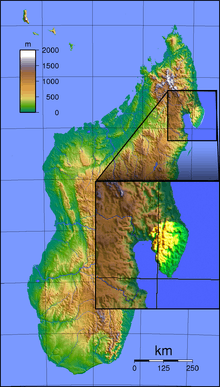Liophidium pattoni
| Liophidium pattoni | |
|---|---|
.jpg) | |
| Scientific classification | |
| Kingdom: | Animalia |
| Phylum: | Chordata |
| Class: | Reptilia |
| Order: | Squamata |
| Suborder: | Serpentes |
| Family: | Lamprophiidae |
| Genus: | Liophidium |
| Species: | L. pattoni |
| Binomial name | |
| Liophidium pattoni | |
Liophidium pattoni is a species of snake of the family Lamprophiidae. Little is known about the snake, as it was recently discovered in 2010.
.jpg)
Geographic range
The snake is found in Madagascar.The species is known in two sites in Madagascar, the Masoala peninsula and the Makira Plateau.[2] From the observation of the species found in Madagascar, they were found in the vegetation area of the primary rainforest. [3]

Phylogeny
Liophidium pattoni is a part of the Liophidium family, which is a genus of lamprophiid snakes. Which means the Liophidium pattoni is harmless to humans. There are nine Liophidium snakes that are endemic Madagascar. The newly discovered species of Liophidium pattoni makes it the tenth Liophidium snake endemic to Madagascar. They are closely related to the Liophidium rhodogaster.[3]
Description
Liophidium pattoni have unique color and patterns. Thin snake with black dorsal side with discontinuous pink stripes but fades body in to blue-gray almost white. The ventral side of the snake is bright yellow but a bright pink stripe at the tail. The ventral side also has black crescent shaped scales. An adult male can be 416.5 mm long and have a Snout-vent length of 329mm, and head length of 12.4 mm.[3]
Diet
Liophidium pattoni hunt through the rainforest for ground animals, such as small lizards like a Madagascar skink. [3]
References
- ↑ "Liophidium pattoni". IUCN Red List of Threatened Species. IUCN. 2011. 2011. Retrieved 25 December 2016.
- ↑ "Red list "Liophidium pattoni"".
- 1 2 3 4 Vieities, David (February 20, 2010). "A rhapsody of colours from Madagascar: discovery of a remarkable new snake of the genus Liophidium and its phylogenetic relationships" (PDF). Salamandra. 46: 10.
See also
- Species Liophidium pattoni at The Reptile Database
